

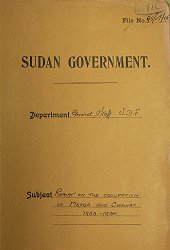
|
The occupation of Merga and Oweinat by the Sudan Defence Force, 1934 Unpublished SDF Operations Diary & photographs by F.G.B. Arkwright |
Anthony and Philip Arkwright, sons of Francis Godfrey Bertram Arkwright have found the photographs presented below in a family album, and have very kindly consented to their reproduction here. These photographs have never appeared in any publication. My sincere thanks to Anthony and Philip for sharing these unique historical photographs with all of us ! The text accompanying the photos (except my notes in italics) is taken from the Sudan Defence Force, General Staff report "Occupation of Merga and Oweinat, 1933-34", housed in the National Archives (formerly Public Records Office), London (document ref: WO 32/3535), suplemented with extracts from the R.A.F. report on the Occupation of Kharkour Murr, Jebel Uweinat (document ref: FO 141/599/4).
Please note and respect that contrary to other photos on this website, no photograph appearing on this page may be copied, re-used or directly linked for any purpose without the explicit written consent of the copyright holders, Anthony & Philip Arkwright.
(Click on the images to see larger versions)
SECRET
OPERATIONS IN THE LIBYAN DESERT 1933-1934
During the course of 1933, as a result of air and land expeditions in the Libyan Desert by Squadron Leader Penderel, Royal Air Force, and Major Bagnold, a party of Italians was discovered in occupation of the wells at AIN DOUA at Jebel OWEINAT. Periodic air reconnaissances by the R.A.F. from Egypt ascertained that the Italian party, consisting of about 30 men with a survey party, were making a more or less permanent base and had constructed an aerodrome at AIN DOUA and another at SARRA Wells, 215 miles west of OWEINAT. Representations were made by the Residency to the Foreign Office with the result conversations were held with the Italian Government in Rome in December, 1933. These conversations broke down as the Italian Government claimed not only Jebel OWEINAT but all country West of Longitude 27 and South to include MERGA but not including BIR NATRUN. In order to substantiate our claim in further conversations, the Foreign Office gave instructions that MERGA and KHARKOUR MURR Wells at OWEINAT should be occupied as soon as possible, unless already held by the Italians. Air reconnaissance was first made to ascertain whether either place was held by the Italians.
OPERATIONS DIARY
| Date. | Event. | Remarks. |
| Dec. 21st. | Foreign Office Telegram No.109. to Residency - requesting Sudan Government to occupy MERGA and the Royal Air Force from Egypt to occupy OWEINAT. | |
| . | ||
| . | ||
| . | ||
| Dec. 23rd. | Telegram to O.C. Western Arab Corps from Headquarters, S.D.F. - warning him of possibility of having to send No. 2. Motor Machine Gun Battery to MERGA, and asking him questions re forming of petrol dumps and suitability of cars. | EL FASHER was chosen as a base for the proposed operations because:- (a) There is a Motor Machine Gun Battery stationed there (b) It is Corps Headquarters with mechanical transport workshops (c) DONGOLA was sugested as a base but it would have to be established first and there is no railway . . . The S.D.F. had not yet received orders from the Sudan Government to take action, therefore only a warning order could be issued this day. |
| . | ||
| . | ||
| . | ||
| Dec. 29th. | The Air Vice Marshal, Middle East, held a discussion with the Kaid el 'Amm at which the Air Staff Officer and Chief Staff Officer were present. | It was agreed at this conference that the Sudan Defence Force would occupy MERGA and Headquarters, Middle East, would be responsible for KARKOUR MURR Well at OWEINAT until taken over by the Sudan Defence Force by Feb. 12th. |
| . | ||
| . | ||
| . | ||
| Jan. 5th. | No.2. Motor Machine Gun Battery under the command of El Bimbashi G.L. Prendergast (companion of Bagnold on all major expeditions, later to become O.C. L.R.D.G.), with S.D.F. Wireless set and four Thornycrofts left EL FASHER at 1400 hours for MALHA. | Headquarters, S.D.F. received definite orders at 1230 hours Jan. 4th. from the Sudan Government to occupy MERGA by Jan. 10th, but that air reconnaissances for BOTH BIR NATRUN and MERGA were to be completed before occupation by ground forces. This naturally entailed a complete reorganisation of loads as aviation petrol had to be carried in addition to the large quantities of M.T. spirit. |
| . | ||
| . | ||
| . | ||
| Jan. 10th. | R.A.F. left MALHA, landed on Battery, refuelled, completed reconnaissance of BIR NATRUN and MERGA according to plan and reported no living thing seen and returned to BIR NATRUN. Battery reported 60 miles South of Wadi SHAU at 0800 hours. | |
| Jan. 11th. | Message received from No.2. M.M.G. Battery asking Headquarters to reconsider further action owing to continuous difficulties with Thornycrofts and his doubts as to whether his transport could get through without the aid of his battery man power. Permission granted to O.C. No.2. M.M.G. Battery to return to EL FASHER, picking up his transport on the way. | |
| . | ||
| . | ||
| . | ||
| Date. | Event. | Remarks. |
| Jan. 12th. | Operation Instruction No.1. issued to O.C. No.1. M.M.G. Battery, KHARTOUM. | No. 1. M.M.G. Battery was ordered to proceed to WADI HALFA to endevour to reach MERGA via LAQIYA OASIS in view of the difficulties of No.2. M.M.G. Battery, who were to return to EL FASHER. No.3. M.M.G. Battery was warned to be ready to take over the task of occupying OWEINAT in place of No.1. M.M.G. Battery. |
| Jan. 13th. | No.1. M.M.G. Battery, under command of El Bimbashi F.G.B. Arkwright left for WADI HALFA. No.2. M.M.G. Battery met El Bimbashi C.G. Henfrey with transport near JEBEL MUTAK, and formulated a plan whereby it would be possible to proceed to MERGA with reduced loads and personnel. Surplus to return with unwanted Thornycrofts. |
|
| Jan. 14th. | No.1. M.M.G. Battery arrived WADI HALFA | Operation Instruction No.2. gave No.1. M.M.G. Battery the task of opening up communications with MERGA via LAQIYA prior to its main and eventual task of occupying OWEINAT. |
| Jan. 15th. | No.2. M.M.G. Battery reached BIR NATRUN | |
| . | ||
| . | ||
| . | ||
| Jan. 15th. | KHARKOUR MOUR Well occupied by flight R.A.F. from Egypt. There were no Italians in occupation. | |

|
|
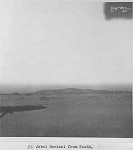
|

|
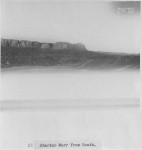
|
||
|
Aerial photos of Jebel Uweinat taken during the reconnaissance flight |
||||
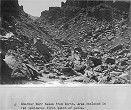
|
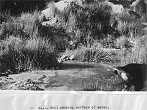
|
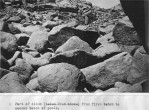
|
||
|
The lower pools of Karkur Murr (Ain Prince) |
||||
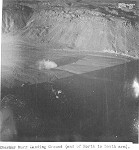
|
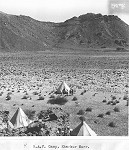
|
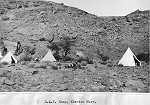
|
||
|
Karkur Murr Landing Ground and R.A.F. camp |
||||
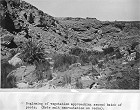
|
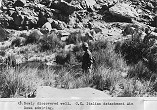
|
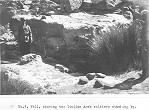
|
||
|
The upper springs of Karkur Murr (Ain Murr). Officer on centre photo is Lt. Terabini. |
||||
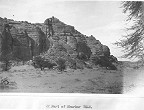
|
|
Karkur Talh |
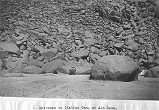
|
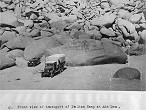
|
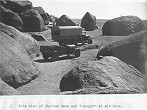
|
||
|
The Italian camp at Ain Doua |
||||
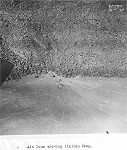
|
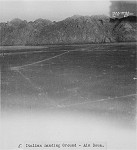
|
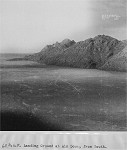
|
||
|
Aerial views of the Ain Doua camp and landing grounds |
||||
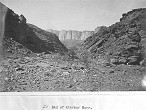
|

|
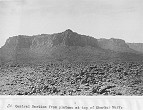
|
||
|
Environs of Karkur Murr |
||||
| Date. | Event. | Remarks. |
| Jan. 17th. | No.2. M.M.G. Battery reached outskirts of MERGA but could not locate entrance to oasis. No.1. M.M.G. Battery left WADI HALFA for SELIMA to form advanced base and to open up Northern L. of C. to MERGA. They did 50 miles with several delays. |
|
| Jan. 18th. | No.2. M.M.G. Battery entered MERGA at 1100 hrs. found it deserted and marked out landing ground. No.1. M.M.G. Battery reached a point 20 miles East of SELIMA. |
|
| Jan. 19th. | No.1. M.M.G. Battery arrived at SELIMA. One battery car broke axle (back). Landing ground marked out and stores dumped. | |
| Jan. 20th. | In view of the later occupation of KHARKOUR MURR Well by No.1. M.M.G. Battery, a reconnaissance of the route for 50 miles was carried out to-day. Found unsuitable for Thornycrofts, two of which had to be abandoned and salved the next day. | |
| Jan. 21th. | No.1. M.M.G. Battery remained at SELIMA to overhaul cars. | |
| Jan. 22nd. | No.1. M.M.G. Battery left SELIMA 1400 hours for LAQIYA OASIS and made 35 miles. | |
| . | ||
| . | ||
| . | ||
| Jan. 25th. | O.C. No.1. M.M.G. Battery reconnoitered entrances to LAQIYA AMRAN without success. | |
| . | ||
| . | ||
| . | ||
| Jan. 28th. | No.1. M.M.G. Battery arrived at SELIMA. | As No.1. M.M.G. Battery were eventually to occupy OWEINAT and the northern L. of C. to MERGA via LAQIYA from WADI HALFA appeared now to be impracticable, the Battery was ordered to return to SELIMA, the advanced base. The Battery had been through a hard time: the cold at nights was intense, and their days were larely spent in pushing vehicles through sand and over rocks, all their efforts to find an entrance to LAQIYA had failed and personnel were consequently somewhat depressed. |
| Jan. 29th. | Mr. Sweeting, Sudan Surveys, arrived at SELIMA with a maintenance convoy from WADI HALFA, in order to navigate the Battery accross the LIBYAN Desert to OWEINAT. | El Bimbashi WALCH, who was in charge of maintenance from WADI HALFA, had fully established SELIMA as an Advanced Base by this date. The Base at WADI HALFA had been established on the West bank of the Nile: all vehicles and stores have to be ferried accross from railhead on the East bank. A workshops lorry had been specially purchased and set up at the base. Between the base and the Advanced Base, convoys of camels and heavy Thornycroft lorries were operating more or less continuously. |
| Date. | Event. | Remarks. |
| Jan. 30th. | A convoy under O.C. No.1. M.M.G. Battery and Navigating Officer left SELIMA at 1230 hours to proceed to a point at Lat. 21.52. Long. 27.22 half way to OWEINAT on Bagnold's Northern route in order to establish a petrol dump. This dump is known as JENA. Progress 48 miles. One Thornycroft stuck badly three times. | |
| Jan. 31st. | No.1. M.M.G. Battery proceeded a further 45 miles and abandoned Thornycroft and then proceeded a further 18 miles. Camped for night. | On this day the record distance of 13 kilometres in 3 hours was accomplished. |
| Feb. 1st. | No.1. M.M.G. Battery proceeded a further 36 miles and established JENA, at approximately 21.51 North 27.20 East. Eight cars returned to bring up stores from the abandoned Thornycroft, while O.C. Battery and Navigating Officer reconnoitred Bagnold's "Easy Gap" in the sand dune belt. All cars at JENA by nightfall. | |
| . | ||
| . | ||
| . | ||
| Feb. 1st. | No.1. M.M.G. Battery arrived at SELIMA having dumped 1,260 gallons of petrol at JENA. | |
| . | ||
| . | ||
| . | ||
| Feb. 6th. | No.1. M.M.G. Battery left SELIMA for OWEINAT and did 115 miles. | No.1. M.M.G. Battery took with it a maintenance convoy under El Bimbashi Walch and the Navigating Officer. All loads were lightened and only essentials carried. For example - no tents were taken by this convoy, consequently much better progress was made. The tyres were let down to their extreme limit. |
| . | ||
| . | ||
| . | ||
| Feb. 8th. | Gap in sand dune found and No.1. M.M.G. Battery proceeded a further 57 miles. Going varied from sand dune to sand sheet with occasional rocky patches. Continuous sticking in sand sheet. | |
| Feb. 9th. | No.1. M.M.G. Battery arrived OWEINAT 1500 hours, and proceeded to take over from R.A.F. | |

|

|
|

|

|
|
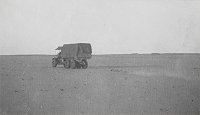
|
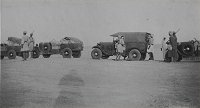
|
|
|
On the way... |
||

|
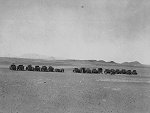
|
|
|
Navigating Officer Sweeting. |
No.1. M.M.G. Battery in sight of Jebel Uweinat. |
|
| Date. | Event. | Remarks. |
| Feb. 12th. | Navigating Officer and wireless set and personnel of R.A.F. left OWENAT at 1300 hours, on a direct bearing on BURG ET TIYUR. At the same time O.C. No.2. M.M.G. Battery left MERGA for BURG ET TIYUR with El Bimbashi Henfrey and two Thornycrofts which were to be evacuated. | |
| . | ||
| . | ||
| . | ||
| Feb. 14th. | Flight of R.A.F. left OWENAT for EGYPT. | |
At this point the SDF Operations Diary ends, subsequent events are based on Arkwright's photographs, references in Almasy's "Recentes Explorations..." and the notes left on the summit of Jebel Uweinat.
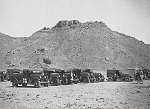
|
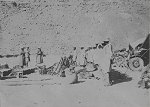
|
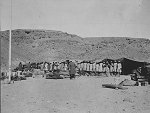
|
||
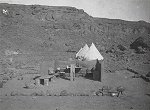
|
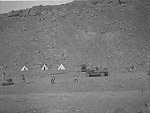
|
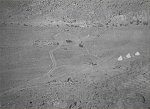
|
||
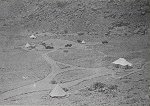
|
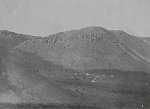
|
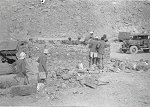
|
The same campsite as seen in October 2004:
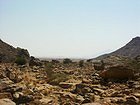
|
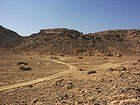
|
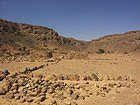
|
Arkwright and Almásy have visited together the wadi to the west of Karkur Murr (named Wadi Wahesh by the 1968 Belgian expedition), and found several rock art sites there (Almásy, Récentes Explorations..., p. 80-81), however apparently no photographic record exists of this visit.
In March 1934 Almásy led a group of Egyptian and expatriate notables to the Gilf Kebir and Jebel Uweinat. During a short stay at Karkur Talh, Almásy succeeded in shooting a Waddan (barbary sheep), and also met with Arkwright. Almásy records in 'Recentes Explorations...' that he made several long treks on the south side of the mountain accompanied by Arkwright, who also showed Almásy a rock shelter he discovered at Jebel Kissu. Almásy copied and reproduced this site (not too accurately) in 'Recentes Explorations...' giving Arkwright full credit for the discovery.
Apparently despite the icy official atittudes, the relations continued at Uweinat between the British and Italian officers in the same good spirit Bagnold and company experienced two years earlier.

|

|

|
||
|
Arkwright and O'Neill meeting Italian officers at Ain Doua. |
O'Neill with italian officers. |
Italian cars at the entrance of Karkur Ibrahim |
||
Thanks to the efforts of Alessandro Menardi Noguera, it is possible to identify the Italian party photographed with Arkwright at Ain Doua: the two persons to the right dressed in civilian suits are Prof. Umberto Mònterin, geologist from Turin University (tall with moustache) and Ing. Renato Tedeschi (short with a white jacket), a geographer from Rome University. It is the only published Mònterin portrait while in Libya. The tall officer on the right of Arkwright is Major Ottavio Rolle, comander of the Kufra garrison, and the officer on the left is Lt. Terabini of the Alpine Corps.
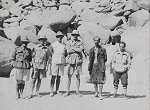
| ||||
|
Left to right: Lt. Terabini, O'Neill, Major Ottavio Rolle, Arkwright, Umberto Monterin, Renato Tedeschi |
In the Arkwright album there is one page of photos showing Kufra, and a campsite possibly near Wadi Sora at the Gilf Kebir. The Ford model A-s appearing on the photos seem to be that of the Almásy party, certainly not the Battery vehicles. Neither Arkwright or any other British officer appears on any of the photos (nor anyone else recognisable), and it is extremely unlikely that Arkwright would have been to Kufra as a guest of the Italians. It is more plausible that Almásy, who is known to have visited Kufra a week earlier, gave these photos to Arkwright. While the photos lack military value, nevertheless it is an interesting addition to the enigmatic picture of Almásy's loyalties. (Certainly in sharp contrast to the Foreign Office assessment of his motives during the same trip.)
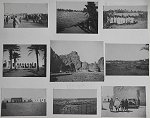
| ||||
|
Photographs of Kufra Oasis in the Arkwright album (plus camp at the Gilf Kebir ?) |
During our first ascent of the peak of Uweinat in November 2001, we have found the damaged note left by the No.1. Motor Machine Gun Battery party in Bagnold's cairn. Research stirred by this find uncovered the SDF report in the Public Records Office, and identified F.G.B. Arkwright as the person likely to have left the note in 1934. Subsequently, in 2002 October we have located the collapsed cairn of the 1933 Marchesi party, and in it the damaged but partially legible peak log. This log confirmed, that on the 2nd April, 1934 F.G.B. Arkwright, Sargent O'Neill and 16 native soldiers reached the summit. Subsequently two other SDF parties made it to the peak in the heat of the summer, following Arkwright's departure. In the Arkwright album, four shots document the ascent:
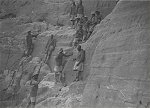
|
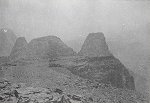
|
|
|
On the way up... |
The "Three Graces" from the summit. |
|

|

|
|
|
Party on the summit, Bagnold's cairn in centre. |
Wiew to the South. |
|
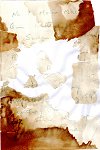 |

|
|
|
The 2001 document hires (1200x1800) |
Page 3. of the peak log hires (1200x889) |
In July 1934, Arkwright left Uweinat for a well earned vacation on the Mediterranean coast at Mersa Matruh. He passed command to Bimbashi E.T. Wyatt (who led a party to the peak of Uweinat on the 12th August, as attested by the peak log). Following the Rome treaty in August fixing the frontier between Libya and Sudan along longitude 25 East, a boundary commission was formed, led from the British side by Wyatt, and colonel De Angostini from the Italian side. Sweeting returned to Uweinat to join the Commission. Two photographs (both taken with De Agostini's camera) were published in "L'illustrazione Italiana" (Vol. LXI, 7 October 1934) showing both the British and Italian team members at a newly erected boundary post (positively identifying Sweeting on the Arkwright photographs).

|

|
|
|
Sweeting and Wyatt. |
The Italian party, De Agostini in right centre. |
Following the Uweinat operation, F.G.B. Arkwright continued as a career officer in the British Army. Attaining a rank of Lt. Colonel, he was killed in action near El Alamein on the 1st of July, 1942, as commanding officer of the 4th County of London Yeomanry. He was awarded the MC for gallantry on active service prior to his death and the DSO posthumously. His gravesite remains unknown, he is listed on the El Alamein War Memorial.
Prior to his military career, F.G.B. Arkwright was a first-class cricket player in the mid-twenties.